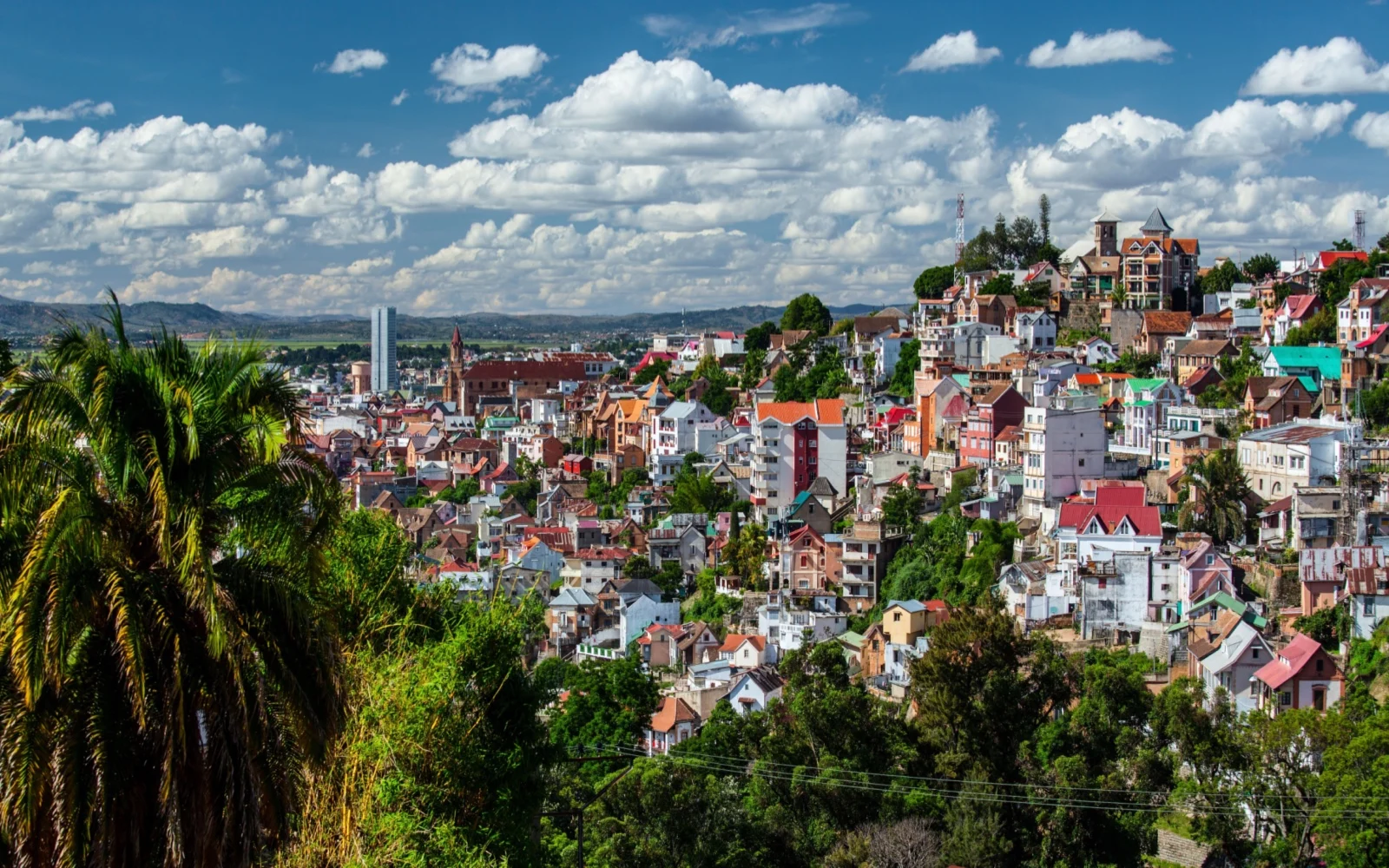What's the best time to visit Madagascar?
June to September is the best time to visit Madagascar overall. It’s the warm dry season with highs ranging from the upper 60s to the upper 80s. This is the perfect time to enjoy Ifaty Beach or Masoala National Park with rainforest hikes, beaches, and wildlife. With limited rain and cultural festivals all through June, it’s a great time to experience Madagascar.
Situated 250 miles off Africa’s coast, the island of Madagascar is known for its diverse and abundant wildlife in the rainforests and cloud forests and unique blends of French and European architecture that make it feel far removed from Africa.
Some people might associate the island with lemurs, thanks to the DreamWorks movie from 2005, and that classification isn’t wrong. Lemurs are all over the island, and there’s even an offshore island you can visit (Lemur Island) filled with the friendly creatures.
But it’s not all wildlife and rainforests. Madagascar’s deep French roots inform the architecture, cuisine, language, and traditions of the cities and villages around the island.
That’s one reason it’s so interesting to visit — technically an African nation, Madagascar feels distinctly European. It can add something special to a trip to nearby Mozambique or Tanzania.
Madagascar is a fascinating place to visit, but some months are much better than others. We’ll show you all the things you need to consider to pick out the right travel dates, including weather, cost, crowds, and events.
Take a look at the overall best time to visit Madagascar, along with the cheapest, least crowded, and worst months for a trip to the island. You’ll gather all the info you need to plan your trip in a way that suits your travel goals!
Overall Best Time to Visit Madagascar

Artush/Shutterstock
The best time to visit Madagascar is June through September. These are dry season winter months with warm weather that’s just right for rainforest hikes, beaches, spotting wildlife and whales, and exploring historic cities and villages around the island.
The dry season runs from May to November for most of Madagascar, making these months better for a visit since you’ll have more opportunities to enjoy outdoor activities and sightseeing. The weather in Madagascar is at its most pleasant this time of year:
- June: 69-88°F; 1-9 rainy days
- July: 68-87°F; 1-9 rainy days
- August: 70-88°F; 1-7 rainy days
- September: 74-89°F; 1-4 rainy days
Tourism varies throughout these months. Peak crowds arrive in August, but you’ll find moderate crowds in June and conditions that are still busy, but less so than August, during July and September.
Head inland to the capital city of Antananarivo for sightseeing. There’s the 17th-century Rove of Antananarivo (Queen’s Palace) with royal tombs on the plateau overlooking the city, a Baroque-style pink palace in Haute Ville district, and serene Lake Anosy with walking paths leading around it.
Check out the many restaurants around the capital for French, Italian, Brazilian, and Asian cuisine along with fresh seafood spots. Most of the eateries here serve French food in casual to upscale settings.
Head to the southeastern island of Nosy Be, just off the coast, to access unspoiled beaches, the historic capital of Hell-Ville with French Colonial architecture, and Lemuria Land park (there’s even an old ylang-ylang essential oil distillery you can tour).
Go whale watching! June through September offer the best chances of spotting humpback whales as they move into warmer waters, so keep an eye out on the eastern coast or Île Sainte-Marie during these months. On Nosy Be, the season is a little later, from August to November.
One of the most beautiful parts of Madagascar is Masoala National Park bordering the warm waters of the Tampolo Marine Reserve. Rainforests teeming with wildlife, beaches studded with boulders and golden sand, and hiking trails make it the perfect spot to visit this time of year.
The cost of visiting Madagascar is reasonable for most of the best months, especially in September — one of the cheapest months to travel here of the year. Here’s what Google Hotels and Kiwi data show:
- June: $60/night; flights from $895
- July: $68/night; flights from $800
- August: $65/night; flights from $1,504
- September: $67/night; flights from $666
You could pay as little as $1,135 for a 7-day trip to Madagascar, airfare included, if you visit during September. Earlier in the season, prices are slightly higher and reach their peak in August.
Consider checking out some of the island’s many events between June and September. June is an especially popular month for cultural festivals:
- Feria Oramena (Jun) is a big seafood festival that feels like a carnival with fresh-caught fish, shellfish, and tasty dishes with ingredients from the sea — especially lobster
- Fisemana (Jun) is a big purification ritual and festival that’s special to the Antakarana people with local customs performed by soothsayers and medicine men
- Famadihana (Jun-Aug) is known as “turning of the bones” and involves taking bodies from local crypts, dressing them in silken cloth, and reburying them
- Independence Day (Jun 26) is celebrated with parades, live music, dancing, and huge feasts with traditionally-prepared foods to commemorate the island’s freedom from colonial rule
- Hiragasy Festival (Jul) has been around for centuries with music, dance, eating, storytelling, and drinking contests near the capital city
- Donia Music Festival (Sept) on Nosy Be at the capital’s Hell-Ville Stadium brings Malagasy music, sporting events, historic traditions and customs, and food and drink to the stadium for a week of events
Overall, there’s no better time to visit Madagascar than from June to September. Pick June if you want smaller crowds or September for the lowest prices during the peak season period.
Cheapest Time to Visit Madagascar
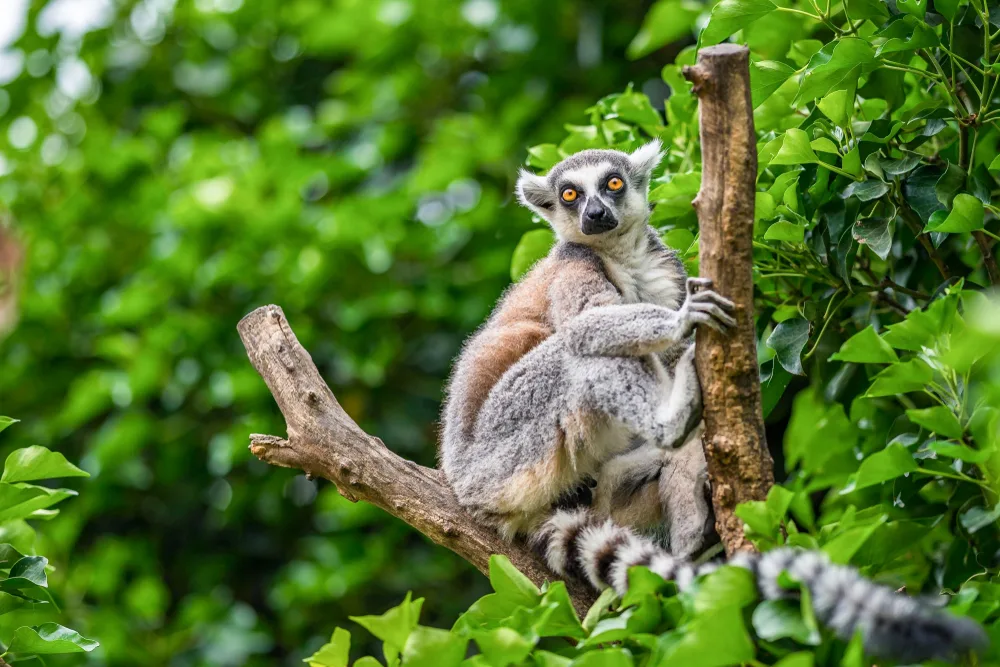
Ondrej_Novotny_92/Shutterstock
The cheapest time to visit Madagascar is between September and March. Affordability makes September through March a great time to visit Madagascar with the lowest hotel prices and airfare of the year.
The weather varies quite a bit during these months, transitioning from the dry season come November into the rainy season. Daily highs are similar the whole time, ranging from the mid-70s to the upper 80s and 90s.
- September: 74-89°F; 1-4 rainy days
- October: 78-90°F; 3-9 rainy days
- November: 80-91°F; 6-16 rainy days
- December: 80-89°F; 10-22 rainy days
- January: 80-88°F; 14-26 rainy days
- February: 79-89°F; 12-24 rainy days
- March: 79-90°F; 7-20 rainy days
January and February are the wettest months of the year in Madagascar, with the capital and areas in the northwest, like Mahajanga, receiving a lot more rain than areas in the southwest and east coasts.
You’ll also notice some differences in how crowded Madagascar is between September and March. As rainfall increases and the cyclone season arrives from February-March, crowds decrease reliably.
October is a peak tourism month. September, November, December, and January are busy. February is moderately busy, and March is one of the least busy months of the year.
Antananarivo is always a little cooler than the coasts and areas inland that aren’t on the Central Plateau. But Toliara, on the southwest coast, sees less rainfall during the warm rainy season and is a better spot to visit during these months.
For an adventure, head to the Tsaratanana Park to see a rugged, volcanic mountain range in the north of the island. Its highest peak at Mount Maramokotro is a popular spot for spotting unique flora and fauna, hiking on scenic trails, and camping out under the stars.
The dry months from September to November are a great time to take an hour-long canoe tour over to Lemur Island, where you’ll be greeted with lemurs who flock to the boat as you feed them bananas. You might see crocodiles and fossas, similar to mongoose, while you’re here! Sunrise is the best time.
Since this is the cheapest time to visit Madagascar, you’ll want to pay attention to how much it’ll cost to visit each month. Take a look at Google Hotels and Kiwi airfare data for each one below:
- September: $67/night; flights from $666
- October: $69/night; flights from $732
- November: $70/night; flights from $663
- December: $71/night; flights from $691
- January: $80/night; flights from $653
- February: $74/night; flights from $653
- March: $74/night; flights from $653
The overall cheapest month to visit Madagascar is September, with a 7-day trip (hotel + airfare only) costing as little as $1,135. Prices aren’t much higher from October to March, so align your travel dates with the weather conditions.
You can attend the Donia Music Festival in September and these events while you’re in Madagascar:
- Alahamadi Be (Mar) is the traditional New Year’s Day celebration with street parties, parades, decorated homes, and feasts with traditional music and dance
- Madajazzcar (Oct) spreads out over 2 weeks in venues around Antananarivo with jazz musicians and bands from the island and around the world with thousands in attendance
We recommend anytime between September and November when it’s dry, with the understanding that October is a very busy month and tends to be crowded in the most popular tourist areas.
Least Busy Time to Visit Madagascar
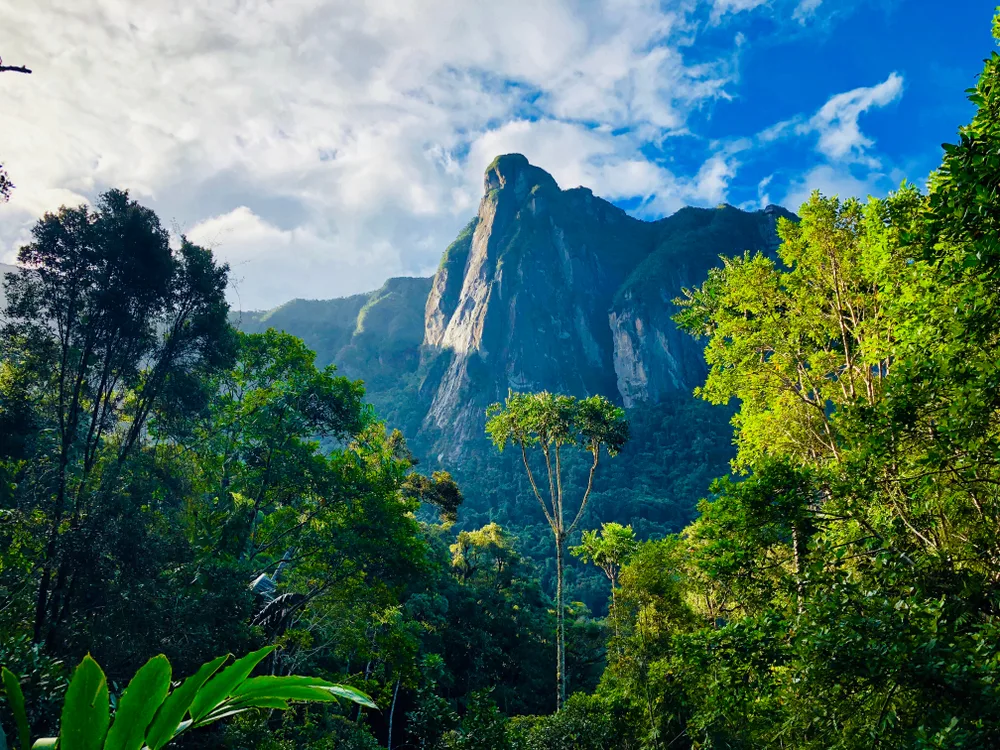
Sean Newbery/Shutterstock
March through May is the least busy time to visit Madagascar. It’s the low season with rainy weather and hot temperatures, so you’ll enjoy smaller crowds while you explore the island.
March, April, and May see highs from the upper 70s to the low 90s. It’s hot and humid, especially in the rainforests. You could see up to 20 rainy days each month this time of year with conditions drying up in May:
- March: 79-90°F; 7-20 rainy days
- April: 77-91°F; 3-13 rainy days
- May: 74-90°F; 2-10 rainy days
Once wet March and April finish up, May welcomes the dry season with fewer rainy days and much better conditions for hanging out at beaches and lagoons, like the buzzing beach town of Ifaty in southwestern Madagascar.
Make time to visit Andasibe-Mantadia National Park to “meet” one of the most unique lemurs on the island, the indri lemur, that’s known for its loud call. You can hike trails to the Sacred Waterfall and see tranquil lakes surrounded by the rainforest in this biodiverse area.
Check out the popular Ranomafana National Park during these less-crowded months to explore rainforested mountains where tons of wildlife, from chameleons to lemurs, lurk in the trees. There are hot springs here and one of the biggest lemur populations on the island!
You have to see the Avenue of the Baobabs in western Madagascar. A dirt road leads you through the distinctive towering, fat-trunked trees in the Menabe region and it’s an amazing spot to grab some photos — sunsets are especially beautiful here.
You’ll find some excellent deals when you visit Madagascar between March and May, especially in March. It’s one of the cheapest months to visit the island, according to data taken from Google Hotels and Kiwi:
- March: $74/night; flights from $653 1171
- April: $75/night; flights from $797 1322
- May: $61/night; flights from $970 1397
You could pay as little as $1,170 for a 7-day trip to Madagascar in March (hotel + airfare included). With low average prices on hotels each month during the low season, it can be a really affordable time to visit.
March marks the Alahamadi Be (traditional Malagasy New Year’s Day celebration) and late April to early May brings the Santabary Festival to celebrate the first rice harvest of the year with feasts, dancing, and music.
If avoiding crowds is important for your trip, you should focus on May for the drier conditions it offers and chances for slightly cooler weather. March is best if you don’t mind the rain and want to score the best deals on low season travel.
Worst Time to Visit Madagascar
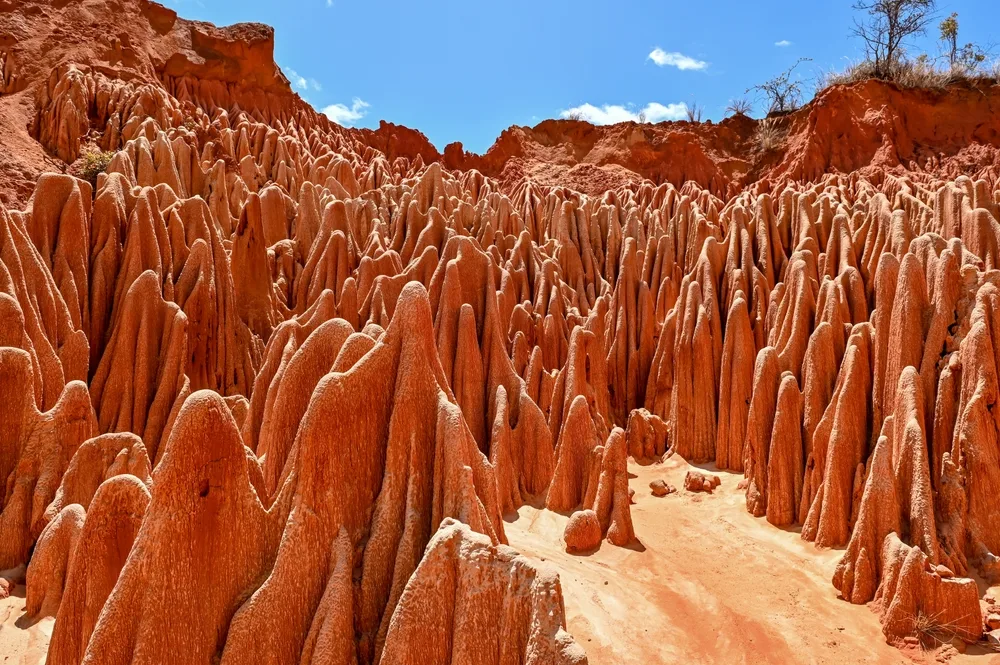
Miroslav Halama/Shutterstock
February-March and August are the worst months to visit Madagascar, depending on your travel goals. February and March are cyclone season, while crowded August sees the highest prices of the year on airfare.
During February and March, monthly rainfall can exceed 20-24 days while highs stay at a sweltering 79-90°F range. August is slightly cooler and much drier, but it’s a busy month for the island with high prices.
- February: 79-89°F; 12-24 rainy days
- March: 79-90°F; 7-20 rainy days
- August: 70-88°F; 1-7 rainy days
Crowds vary during these months dramatically. February sees moderate crowds, March is one of the least busy months of the year, and August is a peak travel month with tons of visitors.
If you’re considering February-March, you’re better off waiting and visiting during May when the dry season begins. If you’re thinking about August, you could change your dates to June, July, or September for smaller crowds and lower prices.
If you have to travel during these months, all is not lost. You can go see a traditional village at Betafo, just outside Antsirabe. Enjoy a homestay experience here through a tour company, meet locals like the medicine man and ghost talker, and end the night with a communal bonfire.
Another option for an immersive trip to the real Madagascar is the village of Ambalavao, where locals handcraft silk and paper and are happy to give tours and demonstrations to travelers.
When it’s cooler in August, you can visit Isalo National Park. It’s like the badlands of South Dakota, but with the addition of natural pools, waterfalls, and tons of ring-tailed lemurs. It can be unbearably hot between October and March.
On the bright side, February and March are two of the cheapest months to visit Madagascar. August is the most expensive month of the year, but it does offer nice weather and opportunities for activities and adventure.
- February: $74/night; flights from $653
- March: $74/night; flights from $653
- August: $65/night; flights from $1,504
We’ve already shared some of the events that take place during these months, including the traditional Malagasy New Year celebration of Alahamadi Be in March. Outside of that, you might find smaller cultural festivals and concerts in the capital.
You’ll always enjoy a trip to Madagascar more during the dry season, so if you have to travel during these months, pick August for its warm, dry weather.
Madagascar by Month: What to Expect
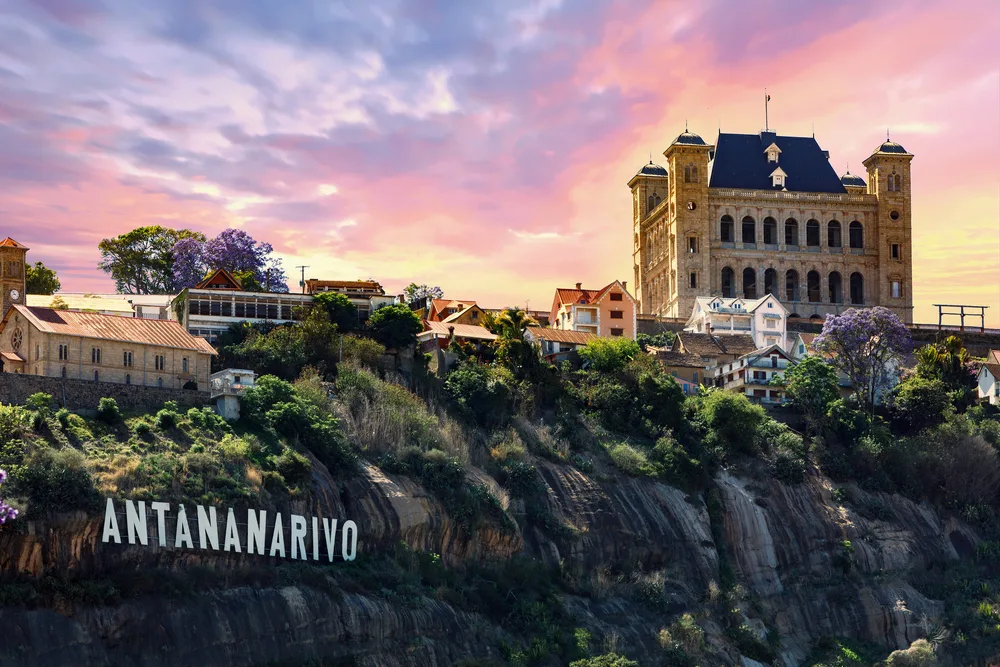
Artush/Shutterstock
Here’s what you can expect in terms of weather, cost, crowds, and activities during each month in Madagascar.
January
Busy January is rainy and hot with highs between 80-88°F and anywhere from 14 to 26 days of rainfall. With hotels priced around $80/night and flights from $653, it’s one of the cheapest months to visit Madagascar. This can be a good time to explore the capital, Antananarivo, and its palace complex.
February
Moderate crowds in February combined with low prices can make it tempting to visit, but highs range from 79-89°F and there are 12-24 rainy days this month. Crowds are smaller because of the rainy season, and prices follow suit with hotels averaging $74/night and flights starting at $653.
March
March is one of the least busy and cheapest months to visit Madagascar. You’ll find hot weather with highs ranging from 79-90°F and anywhere from 7 to 20 rainy days this month. Hotels average just $74/night with flights starting at $653. It’s interesting to be here for the Alahamadi Be New Year’s Day celebrations in the traditional Malagasy way.
April
Quiet April is one of the least crowded months of the year and marks the month when the rainy season begins to wrap up. With 3-13 rainy days and highs ranging from 77-91°F, it’s hot but drier and better for a visit than March. Hotels average $75/night and flights start at $797. Check out the Santabary Festival that celebrates the first rice harvest of the year.
May
May is the final month of the quiet low season with few visitors and hot weather ranging from highs of 74-90°F. The dry season begins this month with just 2-10 rainy days, so it’s a nice time to sightsee, hike through the rainforest, or explore villages along the coast. You’ll spend around $61/night on hotels and upwards of $970 on airfare.
June
Moderate crowds in dry June make it one of the best months to visit with just 1-9 rainy days and highs between 69-88°F. It’s a festival month in Madagascar with events like Feria Oramena, Fisemana, Famadihana, and Independence Day celebrations happening. Hotels are priced around $60/night, but flights start at $895.
July
July is busy and one of the best months in Madagascar with highs between 68°F and 87°F and 1-9 rainy days. This is a good time to relax on Ifaty Beach and dive on the coral reef in the lagoon. Check out the Hiragasy Festival for folksy contests. You’ll pay about $68/night for a hotel and upwards of $800 for round trip airfare.
August
One of the most crowded months of the year, August sees big crowds thanks to its warm (70-88°F), dry (1-7 rainy days) weather. It’s the most expensive month of the year to travel to Madagascar, though, with hotels averaging $65/night and flights costing upwards of $1,500 round trip.
September
September is busy and warm with highs between 74°F and 89°F. There are just 1-4 rainy days this month — one of the driest of the year — and the Donia Music Festival takes place this month. You’ll spend just $67/night on hotels and $666+ on round trip flights, making it both one of the best and cheapest months to visit Madagascar.
October
October is a peak month for Madagascar tourism with dry, warm weather. Highs range from 78-90°F and there are anywhere from 3 to 9 days of rainfall. The popular 2-week Madajazzcar festival happens in the capital this month. You’ll find hotels priced around $69/night and flights starting at $732 round trip.
November
Busy November is the final dry month of the season with 6-16 rainy days and highs between 80°F and 91°F. It’s a popular month to visit ahead of the wet season, and boasts affordable prices (some of the cheapest of the year) around $70/night for hotels and upwards of $663 for flights.
December
December is also busy, but marks the start of the rainy season with anywhere from 10 to 22 days of rainfall this month. Highs are moderate for the season from 80-89°F. You’ll pay around $71/night for your hotel and flights in December start at $691 round trip, making it one of the cheapest months to visit Madagascar.
Frequently Asked Questions

Lubo Ivanko/Shutterstock
Still have some lingering questions about the best time to visit Madagascar? Take a look at the most frequently asked questions below to learn more.
Which month is best to visit Madagascar?
June and September are the best months to visit Madagascar overall. June sees smaller crowds and the most cultural festivals of the year, while September offers the cheapest prices on hotels and airfare of the year. Both are dry season months with warm weather from the upper 60s to the upper 80s.
What is the rainy season in Madagascar?
The rainy season in Madagascar runs from November/December to March/April. A single month can see 24+ days of rainfall during these months and the potential for dangerous cyclones. January and February are typically the rainiest months of the year across Madagascar.
Is Madagascar tourist friendly?
Madagascar is tourist-friendly with plenty of options for hotels, two international airports, lots of French and European restaurants, and shops and markets to explore. But travelers report that its capital, Antananarivo, doesn’t offer great public transportation and can be confusing to navigate.
How many days are enough for Madagascar?
Generally, 7-10 days are enough for Madagascar unless you’re planning on doing a more in-depth trip with lots of time to explore the smaller villages on the outskirts of larger cities and towns. Seven to ten days gives you time to explore the capital, visit beaches on the main island’s coasts, head to Nosy Be and it’s historic Hell-Ville, and do some rainforest hikes through the national parks.
What are the cons for visiting Madagascar?
Madagascar features hot, humid weather for most of the year and when it’s the rainy season, it can pour for up to 24 days out of the month. Flights to Madagascar tend to be expensive and may require 1-2 stops along the way. Madagascar doesn’t have great public transportation, so inter-island travel can be costly and difficult.
What Are the Best Months to Visit Madagascar Overall?
The best time to visit Madagascar is between June and September for the best weather (warm and dry), tons of cultural festivals, and perfect conditions for rainforest hikes, beaches, and city/village exploration.
The cheapest time to visit is between September and March, with the bookend months offering the lowest prices, and the least busy time to visit Madagascar is from April to May when the rainy season transitions into the dry season.
Try to avoid February, March, or August if you’re steering clear of the wettest months with cyclone potential (February-March) or the biggest crowds and highest prices (August).
With wildlife everywhere you look, beautiful tropical fauna, interesting colonial architecture, traditional villages, and sun-soaked beach towns on the coast, Madagascar is truly spectacular to visit when you know the right months to go.
Keep these dates in mind and plan the trip of a lifetime to this African island!



